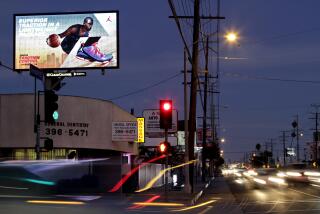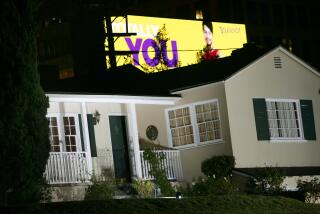Company Gives Advertising a New--and Changing--Face
NEWPORT BEACH â Seeking to reach consumers by cutting through the clutter of ubiquitous advertising, a Newport Beach start-up company has created a display thatâs not quite a poster and not quite a video. Itâs a bit like both.
The Admotion display is a series of four images that change quickly or slowly, depending on the preference of the advertiser. A quick setting could show popcorn popping, for example. Or the display can be set to change slowly so that it pictures a restaurantâs breakfast special in the morning, lunch and dinner specials later in the day.
The display is more eye-catching than a poster, less expensive than video and, most important, itâs something new.
âPeople can see video in their own living rooms,â said John P. Jacobson, a former marketing director for Wang Laboratories Inc. who was hired as chief executive of Admotion.
The display, which runs on electricity, includes a mosaic of four images superimposed on each other on film. Seen as a whole, the mosaic makes little visual sense. But Admotion lays a screen over the top of the mosaic, and the one-millimeter holes filter out all but one image at a time.
The screen moves slightly to show the next image, then the next.
The idea took seven years to perfect, said inventor W.R. (Bill) Bronaugh, Admotionâs chairman. Bronaugh, now retired from a career as a billboard company executive, formerly owned Newport Outdoor in Fullerton.
He said he has patented the Admotion idea in the United States, Europe, Canada and Australia and has applied for a patent in Japan.
Jacobson, who is making sales calls now, said the company hopes to begin production in January. He is pitching to potential customers the several possibilities for the displays: on menu boards, on poles in shopping malls, in grocery-store aisles, at department-store counters. After making a $200 deposit, the customer would pay a monthly fee of $10 to $20, depending on the length of the lease. A business could use the 18-inch-by-18-inch space for its own ads or sell the space at a profit.
Admotion, which is using $2.5 million from investors to get started, hopes to become profitable by October, 1993, Jacobson said.
Investment bank Crest Equities in Newport Beach put together the package of financing for Admotion. Adrian Gluck, president of Crest Equities, also financed start-ups Upper Deck Co. in Yorba Linda, which makes sports trading cards, and Rainbow Technologies in Irvine, which makes devices for computer security.
In-store advertising is a growing business, proponents say, because it costs less than television or radio time and it reaches a select group: likely buyers.
In March, the NBC television network announced plans to sell an advertising package of air time and in-store videos, beginning with grocery stores. In a joint venture with Fleming Cos., a grocery wholesaler based in Oklahoma City, NBC formed a subsidiary called On-Site Media to handle that business. The network said it is trying to link commercials directly to better sales for its advertisers.
What Makes It Different
Hereâs how Admotionâs product works:
* The picture changes, but itâs not on video.
* The four images can be timed to change as fast as once a second or as slowly as once every five hours.
* Customers supply the images and change the film, giving them some creative freedom.
* Itâs relatively cheap: There is a $200 deposit and a $10 to $20 fee each month, depending on the length of the lease. New films are extra.
More to Read
Inside the business of entertainment
The Wide Shot brings you news, analysis and insights on everything from streaming wars to production â and what it all means for the future.
You may occasionally receive promotional content from the Los Angeles Times.










